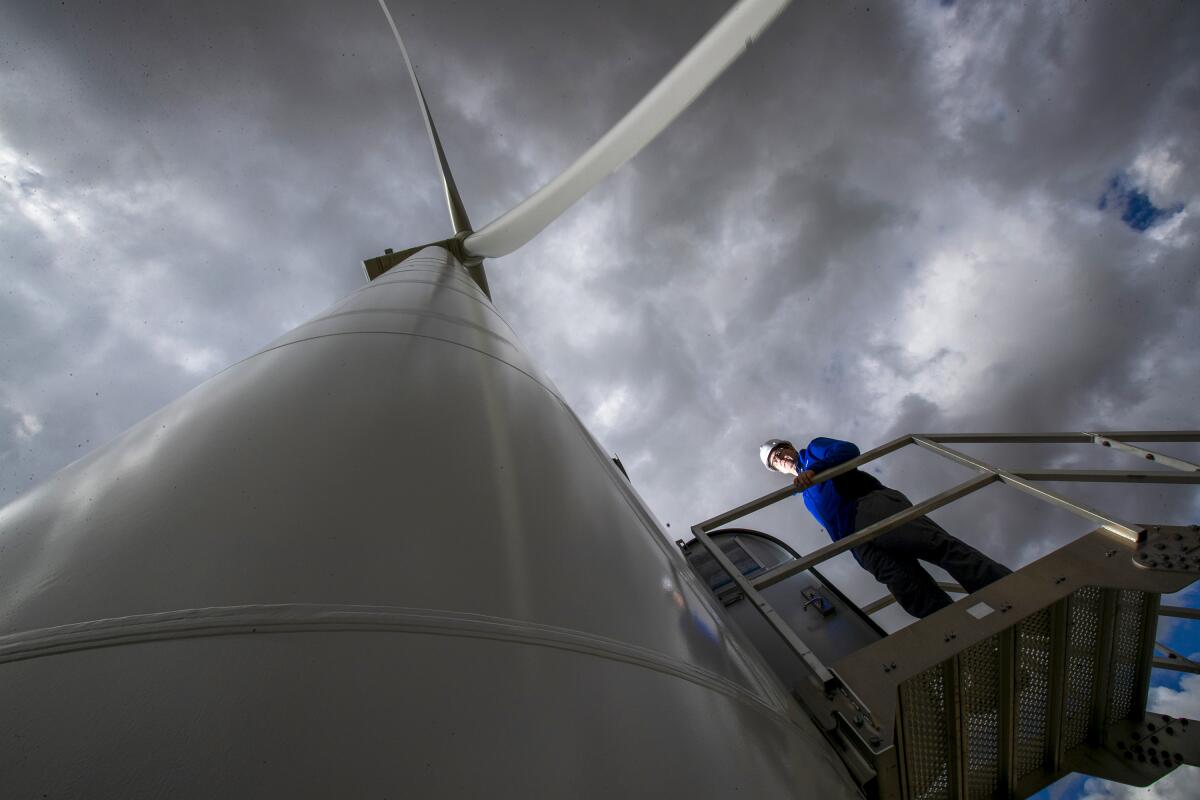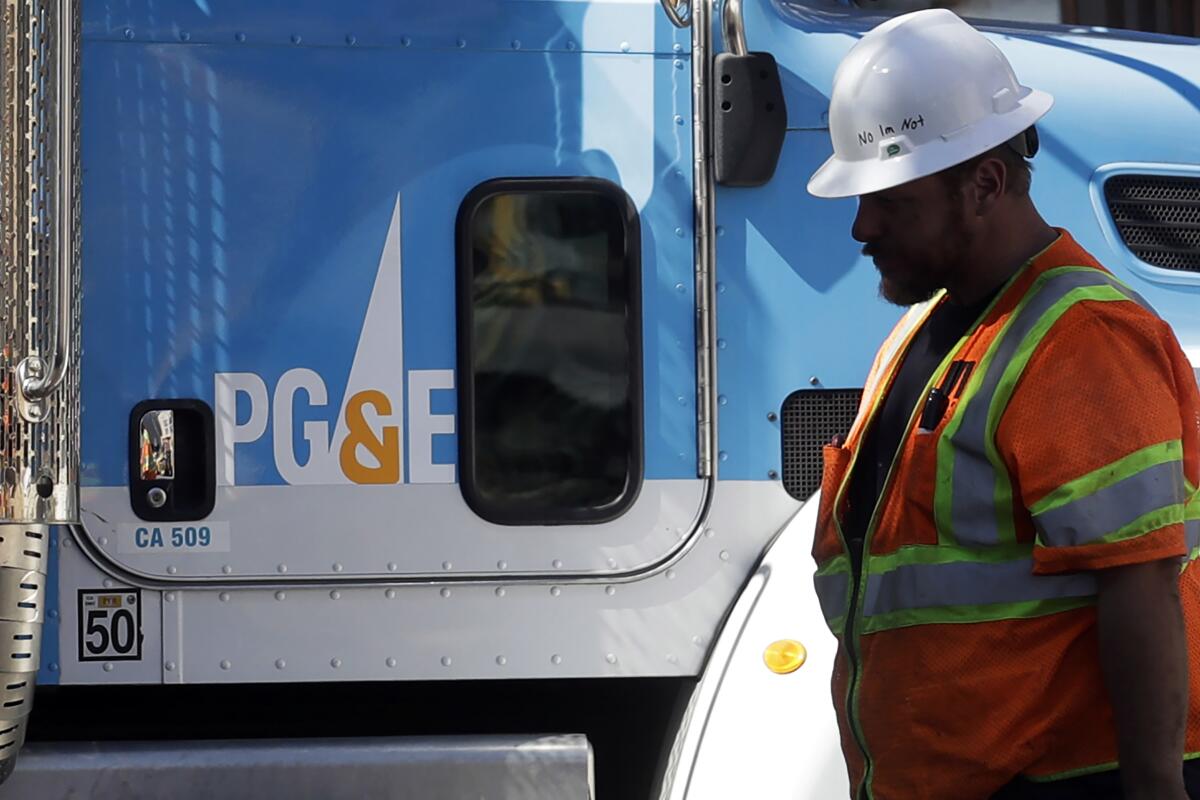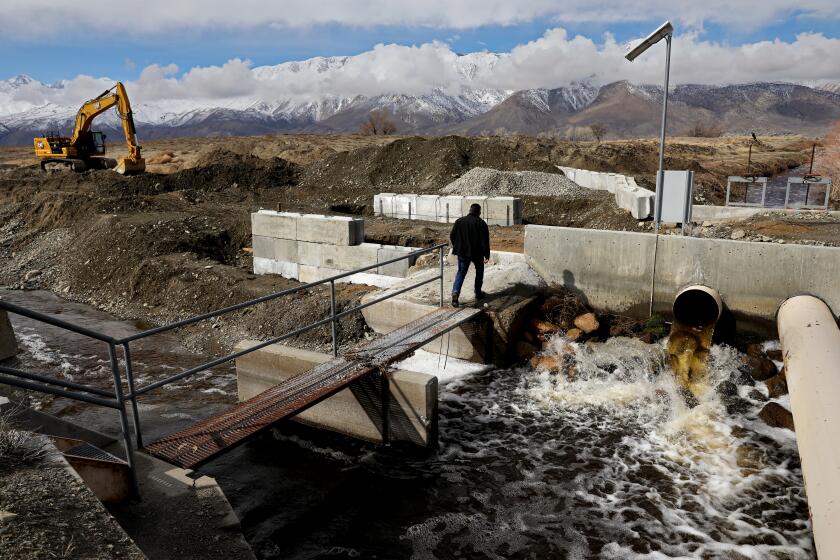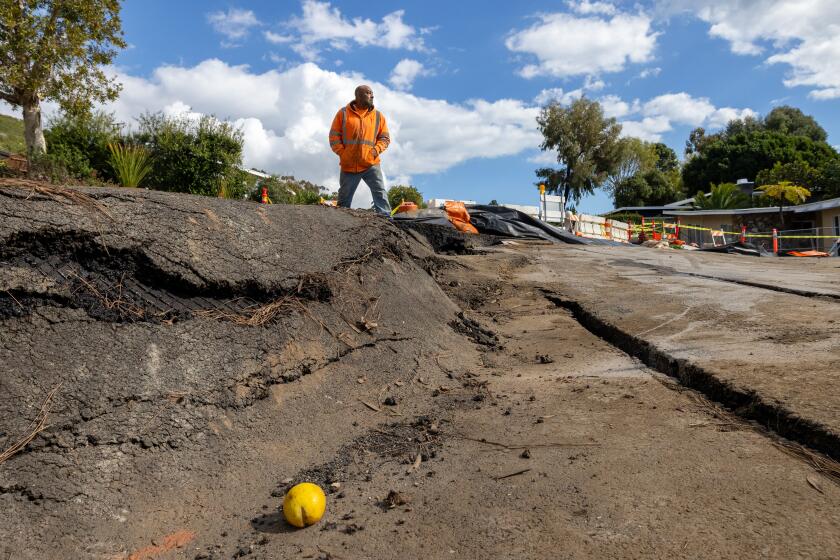Column: Hate the storm? Then start getting serious about climate change

You know how oil and gas pollution is supposed to bring not only hotter heat waves, drier droughts and bigger wildfires, but also more intense storms? Well, that’s what we’re experiencing in Los Angeles and across California this week, as an atmospheric river wallops the state with record rainfall, dangerous floods, major mudslides and power outages — with more to come.
Although it’s too soon to say exactly how much responsibility global warming bears for the storm — let’s hope scientists conduct an attribution study before too long — this is exactly the kind of thing climate researchers have long predicted.
You're reading Boiling Point
Sammy Roth gets you up to speed on climate change, energy and the environment. Sign up to get it in your inbox twice a week.
You may occasionally receive promotional content from the Los Angeles Times.
As The Times’ Grace Toohey wrote last week, scientists have found that because of rising temperatures, a catastrophic storm “is more likely to happen and to be more intense, with a 2% chance of occurring in any given year, as opposed to a 1% likelihood pre-global warming.” Hot ocean waters — heated in large part by fossil fuels — are “moistening the atmospheric river storms as they approach California, making them more likely to deliver heavy rainfall,” Grace and Hayley Smith explained a few days later.
And lest you think these intense downpours will at least solve California’s drought problem? Alas, no. As Ian James reports, the warmer storms of the climate change era are offering more rain and less snow — meaning less mountain snowpack gradually melting and flowing into our canals and reservoirs, the historic pattern around which the state’s water system was built.
It’s not great, folks.
It’s also not too late to do something about it, if we could just stop arguing and start prioritizing.
Whenever I write about the need to accept imperfect climate solutions in the name of averting unimaginable suffering — as I did last week, arguing that a Biden administration plan to develop solar farms across 1 million acres of Western public lands, scary as it may sound, is a hell of a lot better than climate catastrophe — I get furious pushback from readers who don’t understand how I could possibly endorse such a flawed clean energy strategy when there are clearly better options.
Why build giant solar farms that destroy wildlife habitat when we could put solar panels on our roofs? Or, depending on the week, why make people pay for expensive rooftop panels when big solar farms are cheaper? Why not focus on building nuclear reactors that produce electricity 24/7, or persuading Congress to tax fossil fuel pollution, or limiting population growth?
All reasonable questions. All a lot more frustrating now than they would have been 20 or 30 years ago.
Friday’s edition of the comic strip xkcd, by cartoonist Randall Munroe, struck a chord with me. By Munroe’s estimation, scientists first identified the greenhouse effect — that rising carbon dioxide levels in Earth’s atmosphere, driven by industrial activity, could dramatically raise the planet’s temperature — closer to the start of the Industrial Revolution than to today.
How crazy is that?

I’m not saying we should have started building solar panels and wind turbines in 1896, when Swedish chemist Svante Arrhenius first warned of the greenhouse effect. But I am saying we need to find a way to stop yelling past each other about which climate solutions are best — at least if we don’t want this week’s rainstorms to be a harbinger of much worse to come.
I also don’t want to ignore the historic role that coal, oil and gas companies have played in obstructing climate action.
The Climate Investigations Center, a watchdog group, released a fascinating report last week showing that an industry coalition with ties to Southern California Gas, Chevron, General Motors and other companies funded research shedding light on potential harms from carbon pollution way back in the 1950s — decades before climate change would enter the public consciousness in a significant way, and before Exxon and other fossil fuel titans would begin their now-infamous climate denial campaigns.
The polluters knew what was coming. They kept us hooked on their products anyway. This is their fault.
So if you think the key to tackling climate change is ditching an economic system in which greedy corporations profit mercilessly at our expense, I hear you. If you can’t understand why the Biden administration would let renewable energy developers tear up public lands when rooftop solar is an option, I’m sympathetic. We’ll need lots of rooftop solar, no question.
But we need to start facing reality. It’s far too late to resolve the climate crisis without some sacrifices.
Maybe that means driving less, or eating less meat — or replacing your gas furnace by purchasing an electric heat pump, if you can afford one. Maybe it means not objecting the next time a developer proposes affordable apartments near the public transit line in your neighborhood, or being willing to sit in traffic a little while longer if it means more room for bikers and buses.
And maybe it means accepting that the dangers of global warming are so vast — and the odds of revamping American capitalism in the foreseeable future so low — that we should be willing to cede 1 million acres of public lands to solar developers.
This isn’t some theoretical conversation, by the way — public hostility to renewable energy projects is a huge barrier to those projects getting built. A recent survey by Lawrence Berkeley National Laboratory found that “local ordinances or zoning” and “community opposition” are two of the top three reasons cited by solar and wind developers for canceled projects.
There are plenty of legitimate reasons why people might not want solar or wind farms in their backyards, as I’ve covered in our Repowering the West series. Some amount of debate about how to confront the climate crisis is good and necessary.
But that debate needs to revolve around how to stop burning fossil fuels as fast as possible, given the political, economic and technical challenges. Building a perfect world — whatever that means to you — is no longer in the cards. Not in 2024.
If we don’t start accepting that, we’ll look back on this week’s rains as but a trifle.
On that note, here’s what else is happening around the West:
TOP STORIES

A new study finds that the combination of extreme heat and wildfire smoke is worse for our health than just one or the other. Details here from my L.A. Times colleagues Hayley Smith and Corinne Purtill, who write that “when people are exposed to both hazards simultaneously — as is increasingly the case in California — heart and respiratory crises outpace the expected sum of hospitalizations compared to when the conditions occur separately.” Hayley also wrote a story about how quickly planet Earth is approaching 1.5 degrees Celsius of global warming, and why that matters.
Is California doing everything it can to tackle climate change, when state officials keep supporting freeway expansions that are known to promote more car and truck traffic? The short answer: no. The Times’ Rachel Urgana wrote about a recent decision by the California Transportation Commission to provide $200 million to help widen several miles of the 15 Freeway, over objections from climate advocates. As Politico notes, the one commissioner who voted against the funding is being replaced, with state Assembly Speaker Robert Rivas appointing a Ford dealership owner who has championed freeway expansion.
Sick of Southern California’s car culture, which not only fuels climate change but also pollutes our air with toxic fumes? A measure on the March 5 ballot would require Los Angeles to build more bike lanes and bus lanes, and to widen sidewalks. Rachel Uranga explained who’s opposed to Measure HLA, who’s in favor, and the arguments for and against. The Biden administration’s Environmental Protection Agency, meanwhile, is poised to reject Southern California’s plan for cleaning up smog — even as local officials insist the remaining smog is largely the federal government’s fault. Here’s the story from Tony Briscoe.
THE ENERGY TRANSITION
A new analysis finds there may be more than 11,000 gas storage wells in the U.S. with the same key risk as the well that failed at Southern California’s Aliso Canyon storage field, causing the biggest methane leak on record. Floodlight’s Taylor Kate Brown has the story, which serves as an important reminder of the many benefits of phasing out gas heating and cooking beyond limiting climate change. Speaking of which, in case you’ve heard conservative politicians railing against President Biden for banning gas stoves — not only have Biden administration officials not banned gas, they recently struck an industry-friendly compromise over how efficient new gas stoves will need to be, per the Washington Post’s Maxine Joselow.
The California Public Utilities Commission rejected a $744-million Southern California Edison plan to help homes ditch gas appliances, saying Edison customers shouldn’t have to pay for it in their electricity bills. So who should pay? Canary Media’s Jeff St. John explores that question in this excellent piece, tapping into one of the big obstacles facing the much-needed transition to all-electric homes. We have to ditch gas appliances — and gasoline cars too. Speaking of which, as great as it would be to have fast electric vehicle charging stations everywhere, it’s possible that cheaper, slower chargers are the best way to make clean cars a possibility for renters. Here’s an interesting Bay Area case study, courtesy of Grist’s Gabriela Aoun Angueira.
The New Mexico politicians declining to require buffer zones between homes and fossil fuel drilling are getting loads of money from the fossil fuel industry. Large oil and gas companies “gave nearly $800,000 in the past 12 months to Gov. Michelle Lujan Grisham, partisan legislative political action committees and individual state lawmakers,” Marjorie Childress writes for New Mexico In Depth. Also in New Mexico, federal officials quietly scrapped a resource management plan for 4 million acres of public lands, Capital & Main’s Jerry Redfern reports — uniting fossil fuel companies and conservationists in frustration.
AROUND THE WEST

A few months ago, The Times’ Tony Briscoe wrote about the smoldering underground fire at one of Los Angeles County’s largest trash dumps. Now there’s more, with Tony reporting that the landfill fire is spewing toxic fumes into the air breathed by nearby residents. “Environmental regulators say that the local air and water samples have contained elevated levels of benzene, a cancer-causing chemical that evaporates easily. They also have reprimanded Waste Connections, the landfill’s owner, for failing to report the leaks when they first occurred and for not providing area residents with air quality data,” Tony writes.
There’s a compromise in play as Catalina Island residents fight a plan to kill 1,500 invasive deer. The unusual controversy that has roiled a tourist hot spot just off the Southern California coast may be nearing a peaceable conclusion, The Times’ Louis Sahagún writes. Instead of using sharpshooters in helicopters to kill the mule deer — which the Catalina Island Conservancy says are gorging themselves on the island’s delicate native vegetation — the conservancy may now consider other options.
The National Park Service is using camels to help plant and water Joshua trees, as climate-fueled wildfires threaten the beloved plant’s survival. Here’s the super cool Vox story by Miles W. Griffis, who features several adorable camels and writes that their presence “harks back not only to the use of camels as surveyors of historic routes throughout the Mojave Desert in the mid-1800s, but also to their long-distant relatives, Camelops hesternus, or ‘yesterday’s camel,’ that once lived in what is now the Mojave.” The Desert Sun’s Janet Wilson, meanwhile, reports that Joshua Tree National Park saw record visitation last year.
POLITICAL CLIMATE
The U.S. Chamber of Commerce and other industry groups are suing California over its new climate pollution disclosure laws, arguing in part that companies shouldn’t be required to talk about the “politically fraught” topic of climate change. Sen. Scott Wiener (D-San Francisco), who wrote one of the laws, called the lawsuit “straight up climate denial,” as the Associated Press’ Sophie Austin reports. The Chamber’s chief executive says the laws “will not have any notable impact on climate change.”
Gov. Gavin Newsom is pledging to get a bunch of dams torn down — and rivers restored — during his last three years in charge of California. The Associated Press’ Adam Beam joined Newsom as he toured a habitat restoration project designed to benefit salmon, writing that the governor’s environmental record “has been dogged by criticism from environmental groups who say his water policies benefit big agriculture at the expense of salmon and other fish species in danger of becoming extinct.”
A secretive Texas oil baron has played a quiet but significant role in advancing a drilling boom in Utah’s Uinta Basin. If you’ve never heard of Jim Finley, this story by HuffPost’s Chris D’Angelo is worth your time. Elsewhere in Utah, a Senate committee approved a bill that could help the state acquire the Intermountain coal plant — which currently supplies electricity to Los Angeles — and keep it running, rather than letting L.A. shut it down, the Salt Lake Tribune’s Tim Fitzpatrick reports. Utah lawmakers are also considering a bill that would block cities from giving personhood rights to animals, plants and the natural world, Katie Surma reports for Inside Climate News. The bill’s sponsor won’t say whether he thinks it’s OK that corporations have legal personhood.
ONE MORE THING

For a long time, San Diego Gas & Electric charged the highest electricity rates of California utility companies.
No longer.
The top prize now goes to Pacific Gas & Electric, the San Diego Union-Tribune’s Rob Nikolewski reports, following a recent PG&E rate increase approved by Gov. Gavin Newsom’s appointees at the California Public Utilities Commission. But it’s hard to say how long the change will last, with SDG&E — a subsidiary of Sempra Energy — currently requesting another rate hike.
I’ll have more on California’s ever-rising electricity rates in this Thursday’s Boiling Point.
This column is the latest edition of Boiling Point, an email newsletter about climate change and the environment in California and the American West. You can sign up for Boiling Point here. And for more climate and environment news, follow @Sammy_Roth on X.
Toward a more sustainable California
Get Boiling Point, our newsletter exploring climate change, energy and the environment, and become part of the conversation — and the solution.
You may occasionally receive promotional content from the Los Angeles Times.




